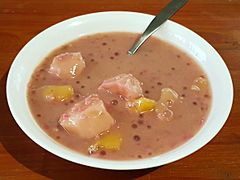Binignit facts for kids

Binignit with saba bananas, taro, jackfruit, ube (purple yam), and sweet potato
|
|
| Alternative names | wit-wit, giná-tan, tinunuan, alpahor, ginettaán, ginat-an, ginat-ang lugaw, pinindot, ginataang bilo-bilo, ginataang halo-halo |
|---|---|
| Course | Dessert |
| Place of origin | Philippines |
| Region or state | Visayas, Mindanao |
| Serving temperature | Hot or cold |
| Main ingredients | glutinous rice, coconut milk, saba, taro, sweet potato, pearl sago, landang |
| Variations | bilo-bilo |
| Similar dishes | lugaw, ginataan |
Binignit is a sweet and creamy dessert soup from the Visayas region in the central Philippines. It's a popular dish made with glutinous rice cooked in rich coconut milk. Many yummy ingredients are added, like slices of sabá bananas, taro, and sweet potato.
This delicious soup is similar to other Filipino desserts called guinataán. These are dishes cooked with coconut milk. One example is bilo-bilo. For the Visayan people, Binignit is often served during Good Friday. This is a special day during Holy Week.
Contents
What are the other names for Binignit?
Binignit has many different names depending on where you are in the Philippines. In the Bikolano region, it's called giná-tan. People in Mindanao Cebuano call it tabirák.
Other names include alpahor in Chavacano and wit-wit in Hiligaynon. In Ilokano, it's known as ginettaán. You might also hear it called ginat-an or ginat-ang lugaw in Waray and Hiligaynon/Ilonggo.
In western Iloilo, it's kamlo. In Tuguegarao City, it's called scramble. People in Bacolod know it as linugaw. Akeanons in Aklan call it eangkuga.
Binignit is a type of lugaw, which is a rice porridge. It's also a guinataán dish, meaning it's cooked in coconut milk.
How is Binignit made?
Making Binignit starts with fresh coconut milk. First, the thick coconut cream is taken from grated mature coconut meat. Then, water is added to the grated coconut to make a thinner coconut milk.
Ingredients for Binignit
The thinner coconut milk is mixed with cubed kamote (sweet potato), gabi (taro), and ube (purple yam). Sliced ripe sabá bananas are also added. Other ingredients include langka (jack fruit) and tapioca pearls. Sometimes, strips of young coconut meat are included too.
Cooking the Dish
This mixture is gently simmered over low to medium heat. This careful cooking stops the coconut milk from curdling. Once the root crops become soft, Glutinous rice (called pilit) is added. The mixture is then brought to a boil and stirred sometimes until it's ready. Just before taking it off the heat, the thick coconut cream is stirred in.
Regional Variations
People on the nearby island of Leyte have their own way of making Binignit. They use landang (palm flour jelly balls), jackfruit, and anise. They also thicken the soup with milled glutinous rice. The vegetables and pearl sago are cooked in water, coconut milk, and landang. They sweeten it with muscovado or brown sugar.
In Panay, their version includes small balls made from glutinous flour. These balls are shaped and boiled until they float, showing they are cooked. Then, they are added to the linugaw or eangkuga. This is similar to how bilo-bilo is made.
When is Binignit enjoyed?
Binignit is a popular snack, especially in the afternoon. It tastes great when served hot. Some people even like it chilled or frozen, eating it like ice cream.
Among the Visayan people, this soup is often cooked and eaten during Holy Week. It's especially popular on Good Friday. This is when many observant Catholics choose to fast and avoid eating meat.
bcl:Ginatan

